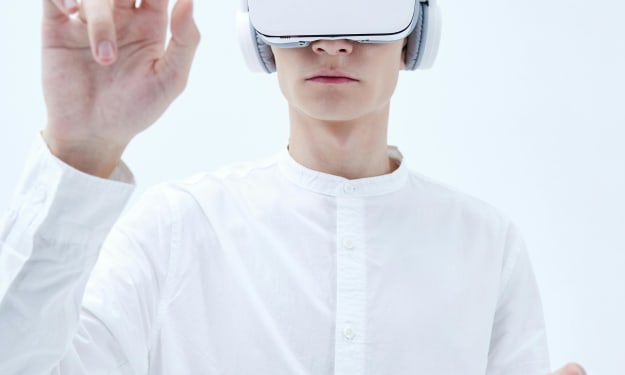Metaverse Health: The Impact of Virtual Reality on Well-being.
Discover how virtual reality is revolutionizing the healthcare industry and improving overall well-being.

The Rise of Virtual Reality in Healthcare
Virtual reality (VR) technology has seen rapid advancements in recent years, and its potential applications in the healthcare industry are becoming increasingly evident. The use of VR in healthcare has the power to transform the way medical professionals deliver care and the way patients experience it. From training healthcare professionals to empowering patients, VR is revolutionizing the healthcare landscape.
One of the key areas where virtual reality is making a significant impact is in medical training. VR allows healthcare professionals to engage in realistic simulations that mimic real-world scenarios, providing them with valuable hands-on experience in a safe and controlled environment. This immersive training experience enhances their knowledge, skills, and decision-making abilities, ultimately leading to better patient outcomes.
In addition to training, VR is also being utilized in the field of surgical planning. Surgeons can use VR technology to create detailed 3D models of a patient's anatomy, allowing them to visualize complex procedures and plan their approach with precision. This not only improves surgical outcomes but also reduces the risk of complications.
Moreover, virtual reality has proven to be a valuable tool in pain management. By immersing patients in virtual environments, VR can distract them from their physical pain and provide a sense of relaxation and calm. This has been particularly effective in reducing pain during procedures such as wound care, dental treatments, and physical therapy sessions.
Overall, the rise of virtual reality in healthcare is transforming the way medical professionals are trained, surgeries are planned, and patients are treated. As the technology continues to evolve, we can expect to see even more innovative applications that improve patient care and well-being.
Enhancing Mental Health through VR Therapy
Mental health is a significant aspect of overall well-being, and virtual reality is proving to be a powerful tool in enhancing mental health outcomes. VR therapy, also known as virtual reality exposure therapy (VRET), is being increasingly used to treat a range of mental health conditions, including anxiety disorders, phobias, and post-traumatic stress disorder (PTSD).
One of the key advantages of VR therapy is its ability to create immersive and controlled environments that allow individuals to confront their fears and anxieties in a safe and supportive setting. For example, someone with a fear of heights can be exposed to virtual environments that simulate being at great heights, gradually helping them overcome their phobia. This exposure therapy has been shown to be highly effective in reducing anxiety and improving overall mental well-being.
Another area where VR therapy is making a significant impact is in the treatment of PTSD. By recreating traumatic events in a controlled virtual environment, VR therapy allows individuals to safely confront and process their traumatic experiences. This exposure-based therapy has shown promising results in reducing PTSD symptoms and improving the quality of life for those affected.
Furthermore, virtual reality is being used in mindfulness and relaxation exercises to reduce stress and promote mental well-being. VR experiences that transport individuals to serene and calming environments can help them unwind, relax, and practice mindfulness techniques, leading to improved mental health.
In conclusion, virtual reality therapy is revolutionizing the field of mental health by providing innovative and effective treatments for various conditions. With its ability to create immersive and controlled environments, VR therapy has the potential to transform the way mental health care is delivered and improve outcomes for individuals.
Physical Rehabilitation with Virtual Reality
Physical rehabilitation is an essential part of the recovery process for individuals with injuries or disabilities. Virtual reality has emerged as a valuable tool in enhancing the effectiveness of physical rehabilitation programs and improving patient outcomes.
One of the key advantages of using virtual reality in physical rehabilitation is its ability to engage patients in enjoyable and interactive exercises. Traditional rehabilitation exercises can often be repetitive and monotonous, leading to decreased motivation and adherence. VR technology offers a more engaging and immersive experience, making rehabilitation exercises more enjoyable and motivating for patients.
Moreover, virtual reality can simulate real-life scenarios and movements, allowing patients to practice functional activities in a safe environment. For example, a patient recovering from a stroke can use VR technology to simulate activities of daily living, such as reaching for objects or walking, in a virtual environment. This promotes motor relearning and improves the patient's confidence and independence.
Additionally, VR technology provides real-time feedback and monitoring, allowing healthcare professionals to track the patient's progress and make necessary adjustments to their rehabilitation program. This personalized approach to rehabilitation ensures that patients receive optimal care and achieve the best possible outcomes.
In summary, virtual reality is transforming physical rehabilitation by making it more engaging, realistic, and effective. By incorporating VR technology into rehabilitation programs, healthcare professionals can enhance patient motivation, promote functional recovery, and improve overall well-being.
Empowering Patients with VR Education
Education plays a crucial role in empowering patients to take control of their health and make informed decisions. Virtual reality is revolutionizing patient education by providing immersive and interactive experiences that enhance understanding and engagement.
One of the key advantages of VR education is its ability to visualize complex medical concepts and procedures. For example, VR can be used to create interactive 3D models of the human body, allowing patients to explore anatomy, understand medical conditions, and visualize treatment options. This visual learning approach helps patients grasp information more effectively and empowers them to actively participate in their healthcare journey.
Furthermore, virtual reality can simulate medical scenarios and allow patients to experience different perspectives. For instance, VR can provide a simulated experience of living with a chronic condition, helping patients develop empathy and a deeper understanding of their own condition or that of others. This immersive learning experience fosters empathy, compassion, and patient-centered care.
Moreover, VR education can also be utilized to train patients in self-care techniques and medication management. Through interactive VR modules, patients can learn how to administer medications, perform medical procedures, or manage their condition effectively. This hands-on training improves patient confidence and self-efficacy, leading to better health outcomes.
In conclusion, virtual reality is transforming patient education by providing immersive and interactive learning experiences. By enhancing understanding, engagement, and empowerment, VR education is empowering patients to become active participants in their own healthcare journey.
Future Potential of Virtual Reality in Well-being
The potential of virtual reality in improving well-being extends far beyond its current applications. As the technology continues to evolve and advance, we can expect to see even more innovative uses of VR in healthcare and overall well-being.
One area of future potential is in the field of telemedicine. Virtual reality has the ability to create immersive and realistic virtual consultations, allowing patients to receive medical care from the comfort of their homes. This can be particularly beneficial for individuals who have limited mobility or live in remote areas with limited access to healthcare facilities.
Another area of future potential is in the treatment of chronic pain. VR technology can be used to create immersive environments that distract patients from their pain, providing them with relief and improving their quality of life. By combining VR with other modalities such as biofeedback and neurofeedback, the potential for pain management becomes even greater.
Furthermore, virtual reality has the potential to revolutionize the field of medical research. VR simulations can be used to create realistic models for drug testing, surgical procedures, and disease progression, allowing researchers to conduct experiments in a controlled and ethical manner. This can accelerate the pace of medical discoveries and improve treatment options for various conditions.
In conclusion, the future potential of virtual reality in well-being is vast and exciting. As technology continues to advance, we can look forward to more innovative applications that enhance patient care, improve outcomes, and revolutionize the healthcare industry.
About the Creator
Enjoyed the story? Support the Creator.
Subscribe for free to receive all their stories in your feed. You could also pledge your support or give them a one-off tip, letting them know you appreciate their work.






Comments
There are no comments for this story
Be the first to respond and start the conversation.